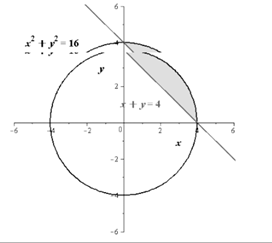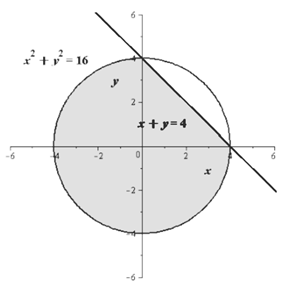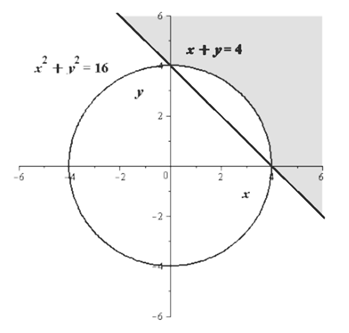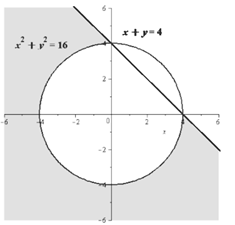
A.)
Match the system of inequalities with the graph of its solution.
A.)
Answer to Problem 75E
The system of inequalities matches to graph (iv)
Explanation of Solution
Given:
The following inequalities
Consider the following inequalities
First use maple to draw the graph of above inequalities

From the above graph it shows that the shaded region is inside the circle
Therefore, the system of inequalities matches to graph (iv)
B.)
Match the system of inequalities with the graph of its solution.
B.)
Answer to Problem 75E
The system of inequalities matches to graph (ii).
Explanation of Solution
Given:
The following inequalities
Consider the following inequalities
First use maple to draw the graph of above inequalities

From the above graph it shows that the shaded region is inside the circle
Therefore, the system of inequalities matches to graph (ii).
C.)
Match the system of inequalities with the graph of its solution.
C.)
Answer to Problem 75E
The system of inequalities matches to graph(iii).
Explanation of Solution
Given:
The following inequalities
Consider the following inequalities
First use maple to draw the graph of above inequalities

The shaded region is outside the circle
Therefore, the system of inequalities matches to graph(iii).
D.)
Match the system of inequalities with the graph of its solution.
D.)
Answer to Problem 75E
The system of inequalities matches to graph (i).
Explanation of Solution
Given:
The following inequalities
Consider the following inequalities
First use maple to draw the graph of above inequalities

The shaded region is outside the circle
Therefore, the system of inequalities matches to graph (i).
Chapter 7 Solutions
EBK PRECALCULUS W/LIMITS
- Let the region R be the area enclosed by the function f(x)= = 3x² and g(x) = 4x. If the region R is the base of a solid such that each cross section perpendicular to the x-axis is an isosceles right triangle with a leg in the region R, find the volume of the solid. You may use a calculator and round to the nearest thousandth. y 11 10 9 00 8 7 9 5 4 3 2 1 -1 -1 x 1 2arrow_forwardLet the region R be the area enclosed by the function f(x) = ex — 1, the horizontal line y = -4 and the vertical lines x = 0 and x = 3. Find the volume of the solid generated when the region R is revolved about the line y = -4. You may use a calculator and round to the nearest thousandth. 20 15 10 5 y I I I | I + -1.5 -1 -0.5 0.5 1 1.5 2 2.5 3 -5 I -10 -15 I + I I T I I + -20 I + -25 I I I -30 I 3.5 4 xarrow_forwardplease show all the workarrow_forward
 Calculus: Early TranscendentalsCalculusISBN:9781285741550Author:James StewartPublisher:Cengage Learning
Calculus: Early TranscendentalsCalculusISBN:9781285741550Author:James StewartPublisher:Cengage Learning Thomas' Calculus (14th Edition)CalculusISBN:9780134438986Author:Joel R. Hass, Christopher E. Heil, Maurice D. WeirPublisher:PEARSON
Thomas' Calculus (14th Edition)CalculusISBN:9780134438986Author:Joel R. Hass, Christopher E. Heil, Maurice D. WeirPublisher:PEARSON Calculus: Early Transcendentals (3rd Edition)CalculusISBN:9780134763644Author:William L. Briggs, Lyle Cochran, Bernard Gillett, Eric SchulzPublisher:PEARSON
Calculus: Early Transcendentals (3rd Edition)CalculusISBN:9780134763644Author:William L. Briggs, Lyle Cochran, Bernard Gillett, Eric SchulzPublisher:PEARSON Calculus: Early TranscendentalsCalculusISBN:9781319050740Author:Jon Rogawski, Colin Adams, Robert FranzosaPublisher:W. H. Freeman
Calculus: Early TranscendentalsCalculusISBN:9781319050740Author:Jon Rogawski, Colin Adams, Robert FranzosaPublisher:W. H. Freeman
 Calculus: Early Transcendental FunctionsCalculusISBN:9781337552516Author:Ron Larson, Bruce H. EdwardsPublisher:Cengage Learning
Calculus: Early Transcendental FunctionsCalculusISBN:9781337552516Author:Ron Larson, Bruce H. EdwardsPublisher:Cengage Learning





